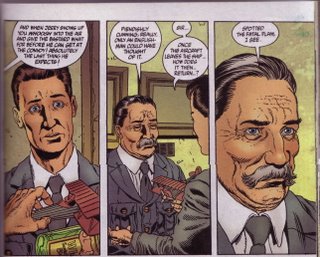So I’ve got this blog, and I’ve been posting to it regularly for almost a month now. I keep linking these things that catch my interest, and I keep saying the same thing to myself: “I’ll think more about this later.” Well, it’s later.
Because, after all, genre is really a way of shelving books in a store. And, in that way, genre is helpful. It answers our questions when we say “I’m in the mood for X, where do I find that that in the bookstore?”
There’s a reason a reader goes to that shelf. If you’re reading science fiction, chances are you want some cool technology or some future shock. If you’re reading a romance, there’d better be some exotic settings, breathless descriptions, and Fabio on the cover.
Most shelves have unique sets of problems the storyteller has to solve. And there may be specific tools that are well-suited for solving them. (And some not as well-suited, that people insist on using anyway.)
On top of that, writers and readers can, sometimes consciously and sometimes not, create traditions that create expectations for readers. Over time, these traditions can ossify into clichés, or even hard-and-fast “rules” that prevent innovation. Then, genre can wind up as a ghetto. “Spaceships? That’s not literature. Go to science fiction.” And you can only graduate from the ghetto if you write some non-genre stuff good enough to be accepted as literature. So William Gibson’s
Pattern Reognition – a stark, present-day novel about a trendspotter with nearly no fantastic elements – gets shelved in Science Fiction, but Margaret Atwood’s
Handmaid’s Tale winds up in Fiction/Literature. (Personally, I think you should shelve them both in both places. But I don’t run a bookstore, and there’s probably good reasons for that.)
Unlike mysteries, unlike science fiction, unlike horror, unlike Westerns (which, if you think about it, are just a specialized historical fiction), historical fiction doesn’t get ghettoized in bookstores. It sits happily on the “Fiction/Literature” shelf. That’s both a good and a bad thing. It’s good, because it means that many authors don’t feel any compunction about writing something set before they were born, and don’t have to worry about whether they’re going to get slotted into a specific shelf on the bookstore.
So why is it bad? Because historical fiction is in a weird spot right now. Most bookstores don’t have a Historical Fiction section, but say the words “historical fiction,” and you’ve created a set of expectations in your listener. So, if you write something, and you call it “historical fiction” (or even if you just set it in the past) then you have to deal with the expectations, because they’ll be sitting there in your reader’s head. The lack of a shelf masks that fact for a lot of people.
One of the good things about genre is that, once it has its own shelf in the bookstore, you get people who think hard about the problems specific to the books on that shelf. There are people who think very hard about science fiction, and romance, and mysteries. A lot of that thinking is crap –constant walling off of what is and isn’t part of the genre, almost-fractal subdivision of genres, endless invention of clever labels. But some of it is genuinely useful.
And, because there are specific problems with writing about history, historical fiction has some problems, some tools, and, of course, some bad habits that are, if not unique to it, at hard for it to deny under oath. It’s worth thinking hard about those, even if it doesn't have its own shelf. And that’s what I want to do here.
Some of this stuff has been sitting in my head a while. I figure I’ll be posting like this about once a week as I think through some of this stuff. I’ll try to figure out a way to label it so people know to skip the long, rambly pieces. Of course, the fact that they’re long is probably a tipoff.





